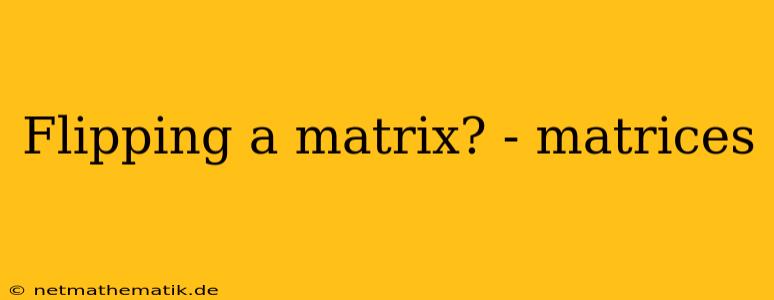Flipping a matrix is a fundamental operation in linear algebra and computer science. It involves rearranging the elements of a matrix by reversing their positions along specific axes. This operation is often used in image processing, data analysis, and computer graphics, where it can be used to create mirror images, rotate objects, or manipulate data. Understanding how to flip matrices is essential for working with these applications.
Understanding Matrix Flipping
A matrix is a rectangular array of numbers, symbols, or expressions arranged in rows and columns. Flipping a matrix involves reflecting the elements of the matrix along a specific axis, effectively creating a mirror image of the original matrix. There are two primary types of matrix flipping:
Horizontal Flipping
Horizontal flipping reflects the elements of the matrix along the vertical axis. In this type of flipping, the rows of the matrix remain in their original positions, but the columns are reversed. The effect is akin to holding a mirror up to the right side of the matrix.
Example:
Original matrix:
1 2 3
4 5 6
7 8 9
Horizontally flipped matrix:
3 2 1
6 5 4
9 8 7
Vertical Flipping
Vertical flipping reflects the elements of the matrix along the horizontal axis. In this type of flipping, the columns of the matrix remain in their original positions, but the rows are reversed. The effect is akin to holding a mirror up to the bottom of the matrix.
Example:
Original matrix:
1 2 3
4 5 6
7 8 9
Vertically flipped matrix:
7 8 9
4 5 6
1 2 3
Flipping Matrices in Python
Python provides powerful libraries like NumPy that make working with matrices, including flipping them, incredibly easy. Here's how you can perform horizontal and vertical flipping using NumPy:
import numpy as np
# Original matrix
matrix = np.array([[1, 2, 3],
[4, 5, 6],
[7, 8, 9]])
# Horizontal flipping
flipped_horizontal = np.fliplr(matrix)
# Vertical flipping
flipped_vertical = np.flipud(matrix)
print("Original Matrix:")
print(matrix)
print("\nHorizontally Flipped Matrix:")
print(flipped_horizontal)
print("\nVertically Flipped Matrix:")
print(flipped_vertical)
This code snippet first imports the NumPy library, defines a sample matrix, and then utilizes the fliplr and flipud functions to perform horizontal and vertical flipping, respectively.
Applications of Matrix Flipping
Flipping matrices has numerous applications across various fields, including:
Image Processing
- Creating mirror images: Flipping matrices can be used to create mirror images of images, which is useful for generating reflections, creating symmetric patterns, or correcting distorted images.
- Rotating images: Combining flipping operations with other transformations like transposition can be used to rotate images by 90, 180, or 270 degrees.
Data Analysis
- Reversing data order: In data analysis, flipping matrices can be used to reverse the order of data points in a dataset, which might be necessary for certain statistical analysis techniques or visualization purposes.
Computer Graphics
- Creating reflections: Flipping matrices is a fundamental operation for creating realistic reflections in computer graphics. By reflecting objects along specific axes, you can simulate the appearance of objects reflected in mirrors or water surfaces.
- Manipulating objects: In 3D computer graphics, flipping matrices can be used to manipulate objects by reflecting them along different axes. This allows for creating different views of objects or creating mirror images of 3D models.
Conclusion
Flipping a matrix is a versatile operation with many applications in various fields. It allows us to manipulate matrices by reflecting them along specific axes, resulting in mirror images or reversed order of elements. Python libraries like NumPy provide convenient functions for flipping matrices, making this operation easy to perform. Understanding matrix flipping is crucial for working with image processing, data analysis, and computer graphics applications, enabling you to create interesting effects and manipulate data effectively.
